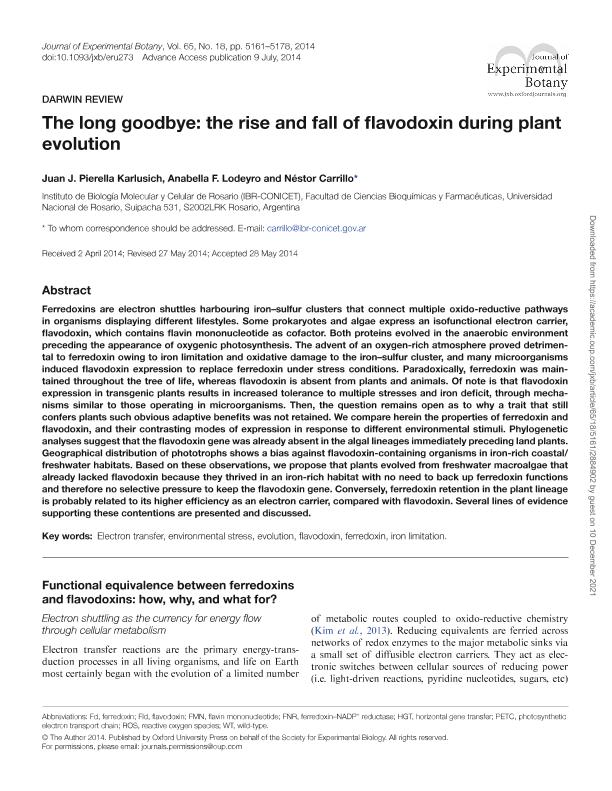Artículo
The long goodbye: the rise and fall of flavodoxin during plant evolution
Fecha de publicación:
07/2014
Editorial:
Oxford University Press
Revista:
Journal Of Experimental Botany
ISSN:
0022-0957
e-ISSN:
1460-2431
Idioma:
Inglés
Tipo de recurso:
Artículo publicado
Clasificación temática:
Resumen
Ferredoxins are electron shuttles harbouring iron–sulfur clusters that connect multiple oxido-reductive pathways in organisms displaying different lifestyles. Some prokaryotes and algae express an isofunctional electron carrier, flavodoxin, which contains flavin mononucleotide as cofactor. Both proteins evolved in the anaerobic environment preceding the appearance of oxygenic photosynthesis. The advent of an oxygen-rich atmosphere proved detrimental to ferredoxin owing to iron limitation and oxidative damage to the iron–sulfur cluster, and many microorganisms induced flavodoxin expression to replace ferredoxin under stress conditions. Paradoxically, ferredoxin was maintained throughout the tree of life, whereas flavodoxin is absent from plants and animals. Of note is that flavodoxin expression in transgenic plants results in increased tolerance to multiple stresses and iron deficit, through mechanisms similar to those operating in microorganisms. Then, the question remains open as to why a trait that still confers plants such obvious adaptive benefits was not retained. We compare herein the properties of ferredoxin and flavodoxin, and their contrasting modes of expression in response to different environmental stimuli. Phylogenetic analyses suggest that the flavodoxin gene was already absent in the algal lineages immediately preceding land plants. Geographical distribution of phototrophs shows a bias against flavodoxin-containing organisms in iron-rich coastal/freshwater habitats. Based on these observations, we propose that plants evolved from freshwater macroalgae that already lacked flavodoxin because they thrived in an iron-rich habitat with no need to back up ferredoxin functions and therefore no selective pressure to keep the flavodoxin gene. Conversely, ferredoxin retention in the plant lineage is probably related to its higher efficiency as an electron carrier, compared with flavodoxin. Several lines of evidence supporting these contentions are presented and discussed.
Palabras clave:
Electron Transfer
,
Environmental Stress
,
Evolution
,
Flavodoxin
Archivos asociados
Licencia
Identificadores
Colecciones
Articulos(IBR)
Articulos de INST.DE BIOLOGIA MOLECULAR Y CELULAR DE ROSARIO
Articulos de INST.DE BIOLOGIA MOLECULAR Y CELULAR DE ROSARIO
Citación
Pierella Karlusich, Juan José; Lodeyro, Anabella Fernanda; Carrillo, Nestor Jose; The long goodbye: the rise and fall of flavodoxin during plant evolution; Oxford University Press; Journal Of Experimental Botany; 65; 18; 7-2014; 5161-5178
Compartir
Altmétricas




